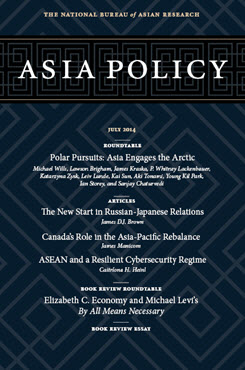South Korea's Interests in the Arctic
This essay is part of the roundtable “Polar Pursuits: Asia Engages the Arctic.”
Since the early 2000s, South Korea’s interest in the Arctic has gradually grown in parallel with the acceleration of the melting of the Arctic sea ice. This interest peaked on May 15, 2013, when South Korea obtained observer status in the Arctic Council. Afterward, the headlines of newspapers were full of rosy depictions of the enormous benefits that such status would bring to South Korea. One year later, however, interest in the Arctic seems to have cooled. This essay examines South Korea’s interests in the Arctic. It addresses five sets of issues: South Korea’s economic interests in the Arctic, obstacles to the development of these interests, South Korea’s involvement in Arctic governance, the Arctic Policy Master Plan, and the challenges ahead for the country.
South Korea’s Economic Interests in the Arctic
South Korea’s keen interest in the Arctic is due to the expectation that the region could become a driver of economic growth similar to the Middle East during the construction boom in the 1970s. The reasoning behind these expectation can be divided into the following four categories. [1]
First, it is expected that South Korea’s companies and experts will participate actively in the development and exploitation of energy resources in the Arctic. The U.S. Geological Survey’s report that 13% of the world’s oil reserves (about 90 billion barrels) and 30% of all natural gas reserves (about 47 trillion cubic meters) are held in the Arctic has certainly piqued South Korea’s interest. [2]As of 2013, South Korea imported 61.8% of its oil from Saudi Arabia, Kuwait, and the United Arab Emirates and about 53.3% of its natural gas from Qatar, Indonesia, and Malaysia. [3] Currently, the South Korean government provides incentives for oil imported from outside the Middle East with the goal of diversifying imports and becoming less dependent on Middle East oil. Expert analysis indicates that South Korea would save approximately $1 billion annually in transportation costs if Arctic oil replaced just 10% of Middle East oil. [4]
Second, interest in savings generated from using the Northern Sea Route (NSR) also encourages high economic expectations for the Arctic. Current sea routes connect South Korea with northern Europe through the Strait of Malacca and the Suez Canal. The NSR would decrease the transportation distance by 40% (about 8,000 kilometers, or 4,970 miles), thereby reducing travel time by up to ten days and cutting fuel costs by 25%. [5] These gains would increase the competitiveness of South Korean products on the European market. Given that 99% of South Korea’s trade volume is handled via shipping and that Northern Europe is one of the country’s major trade partners, opening an Arctic route would significantly benefit the South Korean economy. In order to promote use of the NSR, the South Korean government provides various incentives such as discounts on charges for port usage. Because of such measures, Stena Polaris, a freighter operated by the South Korean logistics company Hyundai Glovis, completed South Korea’s first commercial freight voyage via the Arctic Ocean on October 22, 2013, after taking only 35 days to make the journey from the Russian port of Ust-Luga to the South Koran port of Gwangyang.
Third, there has been an increase in demand for offshore platforms and special vessels, such as icebreakers and ice-hardened ships, since the beginning of the new era of Arctic resource development and the opening of the Arctic sea routes. South Korean shipbuilders such as Hyundai Heavy Industries, Samsung Heavy Industries, and Daewoo Shipbuilding and Marine Engineering (DSME) are among the most competitive companies in the world for production of these high-value-added ships. In March 2014, DSME won a $300 million order from Russia’s state-owned shipping company Sovcomflot to construct an icebreaking liquefied natural gas (LNG) carrier. This agreement is part of Russia’s Yamal project, which…
Endnotes
[1] Although South Korea’s level of scientific interest and activity in the Arctic has been relatively low compared with that in the Antarctic, a plan to invigorate Arctic-related activities is in progress now that the country has obtained observer status in the Arctic Council. For example, while Korea has two comprehensive scientific research bases in Antarctica, Sejong Station and Janbogo Station, there is only one Korean Arctic research station, Dasan, at Ny-Ålesund in the Svalbard islands, which leases part of a small building for a couple of months every year.
[2] U.S. Geological Survey, “Circum-Arctic Appraisal: Estimates of Undiscovered Oil and Gas North of Arctic Circle,” Fact Sheet, 2008. http://pubs.usgs.gov/fs/2008/3049/fs2008-3049.pdf. South Korea has been exploiting 0.4 million tons of liquefied natural gas (LNG) per year in the East Sea area.
[3] “Jinanhae jeonchae eneji suipryangsuipaik modu gamso” [Last Year, Volume and Amounts of Energy Were Reduced], NTN, January 16, 2014, http://www.intn.co.kr/news/articleView.html?idxno=237997.
[4] Sung-Woo Lee, “Potential and Protect of the Arctic Use” (presentation for the 1st Policy Forum for the Arctic Strategy, September 2012), 78 [in Korean]. Sung-Woo Lee et al., Shipping and Port Condition Changes and Throughout Prospects with Opening of the Northern Sea Route (Seoul: Korea Maritime Institute, 2011) [in Korean].
[5] Sung-Woo Lee et al., Shipping and Port Condition Changes and Throughout Prospects with Opening of the Northern Sea Route (Seoul: Korea Maritime Institute, 2011) [in Korean].
About Asia Policy
Asia Policy is a peer-reviewed scholarly journal presenting policy-relevant academic research on the Asia-Pacific that draws clear and concise conclusions useful to today’s policymakers. Asia Policy is published quarterly in January, April, July, and October and accepts submissions on a rolling basis. Learn more


